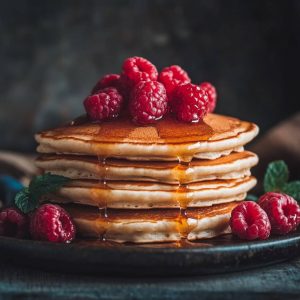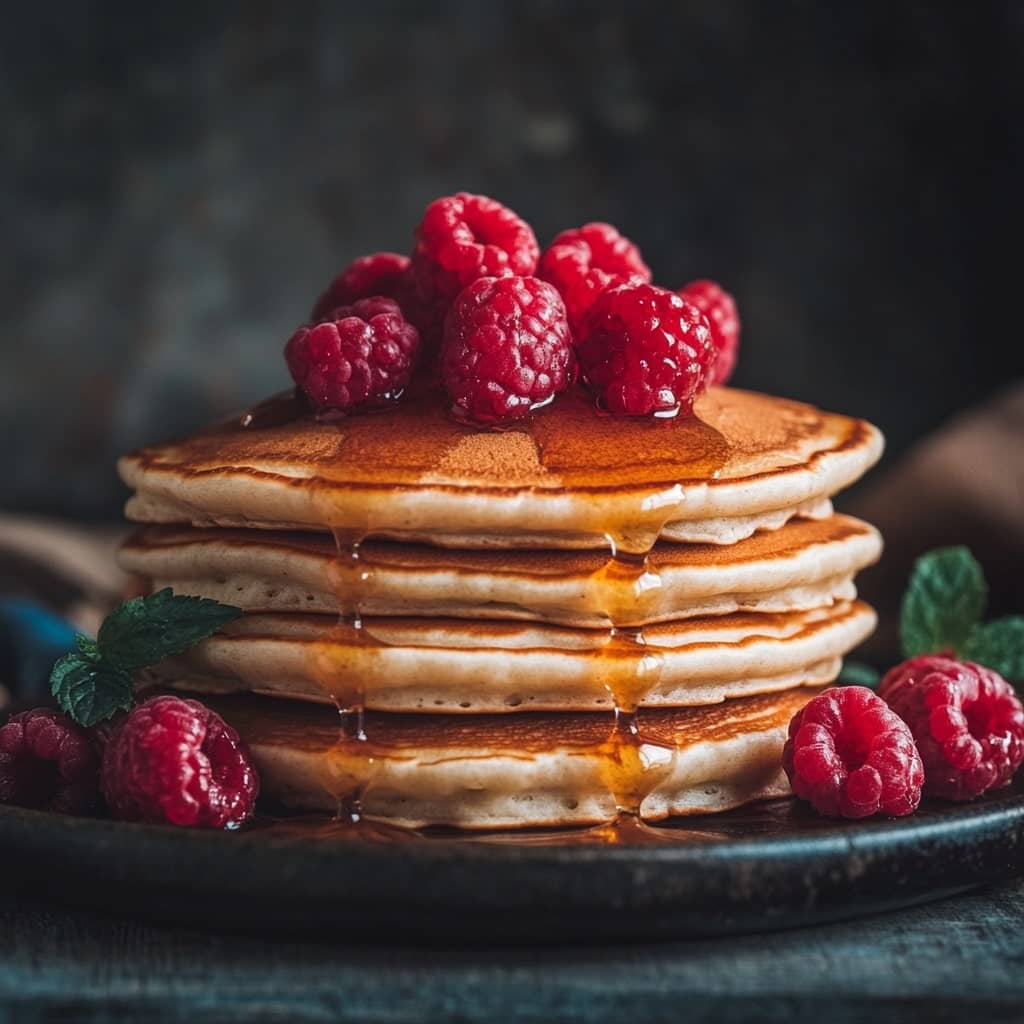Fluffy pancakes are a quintessential breakfast dish that brings comfort and warmth to any morning. Whether enjoyed with a drizzle of maple syrup, fresh berries, or a dollop of whipped cream, fluffy pancakes are a versatile and indulgent treat. Known for their light, airy texture and tender crumb, these pancakes are the perfect way to start the day. The key to achieving that perfect fluffiness lies in the balance of ingredients, proper mixing, and the magic of the griddle. While pancakes are enjoyed worldwide, the American-style fluffy pancakes are particularly loved for their rise, golden-brown edges, and soft, melt-in-your-mouth consistency. Ideal for family breakfasts, brunch gatherings, or a special weekend treat, these pancakes promise to deliver both nostalgia and satisfaction with every bite.
The History of Fluffy Pancakes
Pancakes, in some form, have been part of the human diet for centuries, but the fluffy, thick style of pancakes most commonly associated with breakfast in America has its roots in the 19th century. Early pancakes date back to ancient Greece, where they were made from flour, water, and honey, cooked on a hot stone. Over time, pancake recipes evolved with the addition of eggs, milk, and baking agents like baking powder, which allowed pancakes to rise and achieve that coveted fluffy texture. In the United States, pancakes became a breakfast staple with the rise of the industrial revolution, when mass-produced ingredients like flour and baking powder became more widely available. By the early 1900s, pancakes had become a standard breakfast food in American households, with recipes appearing in cookbooks, and the popularity of fluffy pancakes soared during the 1950s, thanks to the advent of packaged pancake mixes. Today, fluffy pancakes remain an iconic part of breakfast culture across the world, with countless variations and toppings, from fruit and syrup to whipped cream and chocolate chips.
Ingredients Breakdown
The ingredients for fluffy pancakes are simple, but each one plays a crucial role in achieving that tender, light texture. All-Purpose Flour – This is the base for the pancakes, providing structure and stability. The flour absorbs the liquid ingredients, helping to hold the batter together. Baking Powder – The leavening agent that helps the pancakes rise and become fluffy by creating air pockets in the batter. Sugar – A small amount of sugar is added to sweeten the pancakes and enhance the golden-brown color when cooked. Salt – A pinch of salt balances the sweetness of the pancakes and enhances the flavors of the other ingredients. Eggs – Eggs add structure to the batter and help bind the ingredients together. They also contribute to the pancakes’ tenderness and fluffiness. Milk – Milk adds moisture and helps to create a smooth batter. It also activates the baking powder, contributing to the pancakes’ fluffiness. Butter – Melted butter adds richness and flavor to the pancakes, while also helping to create a tender texture. Vanilla Extract – A splash of vanilla extract adds a subtle, sweet aroma that enhances the overall flavor of the pancakes. Oil or Butter for Cooking – A small amount of oil or butter is used to grease the griddle or frying pan, preventing the pancakes from sticking and helping them cook evenly.
Step-by-Step Recipe
- Prepare the Dry Ingredients: In a large bowl, whisk together 1 ½ cups of all-purpose flour, 2 tablespoons of sugar, 2 teaspoons of baking powder, and a pinch of salt. This will ensure the dry ingredients are evenly distributed and the baking powder is well-incorporated.
- Mix the Wet Ingredients: In a separate bowl, whisk together 1 egg, 1 cup of milk, 2 tablespoons of melted butter, and 1 teaspoon of vanilla extract. Whisk until the ingredients are fully combined and smooth.
- Combine Wet and Dry Ingredients: Pour the wet ingredients into the dry ingredients. Stir gently with a spatula or whisk until just combined. Be careful not to overmix; a few lumps in the batter are perfectly fine. Overmixing can result in dense pancakes, so it’s important to keep the batter slightly lumpy for the best texture.
- Heat the Griddle or Pan: Preheat a griddle or large frying pan over medium heat. Lightly grease the surface with butter or oil to prevent sticking.
- Cook the Pancakes: Once the griddle is hot, spoon about ¼ cup of batter onto the surface for each pancake. Cook until bubbles form on the surface of the pancake and the edges begin to look set, about 2-3 minutes. Flip the pancake and cook for another 1-2 minutes on the other side until golden brown.
- Serve: Serve the pancakes hot with your favorite toppings, such as maple syrup, fresh berries, whipped cream, or a dusting of powdered sugar.
Tips for the Perfect Fluffy Pancakes
The key to fluffy pancakes lies in not overmixing the batter. Mix the ingredients until they are just combined, leaving some lumps in the batter. Overmixing causes the gluten in the flour to develop too much, leading to tough, dense pancakes. Ensure your griddle or pan is hot enough before adding the batter, but not too hot, as this will cause the pancakes to cook too quickly on the outside while remaining raw inside. For an extra fluffy result, you can separate the egg whites and yolks. Beat the egg whites until stiff peaks form and gently fold them into the batter at the end for added airiness. Don’t press down on the pancakes with a spatula while cooking, as this will flatten them and make them less fluffy. If you prefer larger pancakes, use a larger spoonful of batter and allow the pancakes to cook a little longer on low heat to ensure they cook through without burning. Finally, always serve pancakes immediately after cooking for the best texture, or keep them warm in a low-temperature oven while you cook the rest of the batch.
Variations and Customizations
Fluffy pancakes can be easily customized to suit different tastes and dietary needs. Chocolate Chip Pancakes: Add a handful of chocolate chips to the batter for a sweet, indulgent twist. Banana Pancakes: Mash half a ripe banana and stir it into the batter for a natural sweetness and extra moisture. Blueberry Pancakes: Gently fold fresh or frozen blueberries into the batter for a burst of fruity flavor. Whole Wheat Pancakes: Substitute whole wheat flour for half of the all-purpose flour to add more fiber and nutrients. Vegan Pancakes: Use a non-dairy milk (like almond or oat milk), replace the egg with a flaxseed egg (1 tablespoon ground flaxseed + 3 tablespoons water), and substitute vegan butter or oil. Gluten-Free Pancakes: Use a gluten-free flour blend instead of all-purpose flour for a gluten-free version. Cinnamon Pancakes: Add a teaspoon of cinnamon to the dry ingredients for a warm, spiced flavor. Peanut Butter Pancakes: Swirl a tablespoon of peanut butter into the batter for a nutty, creamy flavor.
Health Considerations and Nutritional Value
Fluffy pancakes are a delicious treat, but they are typically high in carbohydrates and can be calorie-dense, especially when topped with syrup and butter. To make them a bit healthier, you can use whole wheat flour or oat flour to increase the fiber content. Reducing the sugar or opting for a natural sweetener like honey or maple syrup can also help lower the glycemic index. Adding fresh fruit like berries or banana slices to your pancakes increases their vitamin and antioxidant content. For a more protein-rich breakfast, you can incorporate a scoop of protein powder into the batter or serve your pancakes with a side of Greek yogurt. While pancakes can be a source of quick energy, they should be enjoyed in moderation as part of a balanced diet. One regular-sized pancake (without toppings) typically contains around 100-150 calories, depending on the ingredients.
FAQ
Q: Can I make the pancake batter ahead of time?
A: Yes, you can prepare the batter in advance and store it in the refrigerator for up to 24 hours. Be sure to stir gently before using it, as the ingredients may settle.
Q: Can I freeze leftover pancakes?
A: Absolutely! Allow the pancakes to cool completely, then stack them with parchment paper in between and store them in a freezer-safe bag or container. Reheat in a toaster or oven when ready to serve.
Q: Why are my pancakes not fluffy?
A: The most common reason for dense pancakes is overmixing the batter. Mix until the ingredients are just combined, and leave the batter a bit lumpy for the best fluffiness. Also, ensure your baking powder is fresh, as old leavening agents can affect the rise.
Q: Can I use almond milk or another non-dairy milk?
A: Yes, you can substitute almond milk or any other plant-based milk for dairy milk. Just make sure to choose unsweetened varieties for the best taste.
Q: How can I keep pancakes warm while making a large batch?
A: Place cooked pancakes on a baking sheet in a single layer and keep them warm in a 200°F (90°C) oven while you finish cooking the rest.

Fluffy Pancakes
Ingredients
- ¾ cup of milk
- 2 tablespoons of white vinegar
- 1 cup of all-purpose flour
- 2 tablespoons of white sugar
- 1 teaspoon of baking powder
- ½ teaspoon of baking soda
- ½ teaspoon of salt
- 1 egg
- 2 tablespoons of melted butter
- Cooking spray
Instructions
- Start by gathering all the ingredients.
- To make sour milk, combine the milk and vinegar in a medium bowl and let it sit for about 5 minutes.
- In a large mixing bowl, whisk together the flour, sugar, baking powder, baking soda, and salt.
- Next, whisk the egg and melted butter into the soured milk mixture.
- Pour the dry flour mixture into the wet milk mixture, and whisk until the batter is smooth and free of lumps.
- Preheat a large skillet over medium heat and lightly coat it with cooking spray. Pour ¼ cup of batter onto the skillet for each pancake and cook until bubbles form on the surface and the edges look dry, about 2 to 3 minutes.
- Flip the pancakes with a spatula and cook for another 1-2 minutes until browned on the other side. Repeat the process with the remaining batter.

